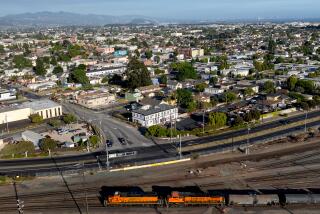Letting Story, Not Money, Guide Light
From time to time, one encounters a person or institution whose fabled reputation is not a bit inflated or sullied by fakery. In a perfect world, these paragons would be showered with honors and resources. In the real world, they have to struggle along like the rest of us.
That’s the situation in which we find the Point Reyes Light and its owner, David V. Mitchell.
The weekly Light (circulation about 4,000) is the newspaper in rural western Marin County that won a Pulitzer Prize in 1979 for its reporting on Synanon, a drug rehabilitation program that had evolved into a violent cult.
Mitchell, who has owned and operated the paper in a nearly unbroken stretch since 1975, has never let the Synanon series stand unchallenged as a high point. The Light is a crusading newspaper whose lofty standards often stand as a reproach to the timidity and blandness of much bigger publications.
The question is how long this unique enterprise can continue. As a recent article in SF Weekly disclosed, Mitchell has kept the Light financially afloat out of his own pocket for the last few years, drawing down a $300,000 bequest inherited from his father in 1984. This year the paper is expected to lose about $30,000, a rate that will leave the 61-year-old Mitchell out of cash before too long.
The article has galvanized some local fans into action. Tom Sebastian, a local marketing executive, has offered to help attract ads from major retailers such as Home Depot and Safeway. He’s also hoping to recruit a few well-heeled neighbors to shore up the Light’s balance sheet by making small, silent equity investments.
That’s a sign of the importance of the Light to residents of the 14 communities of sparsely populated West Marin.
“Many people have said the concept of West Marin is itself a creation of the Light,” Mitchell told me this week in the converted Point Reyes Station creamery that houses its offices. (He wasn’t taking credit; the paper existed for 27 years before he bought it with his then-wife, Cathy, in 1975.)
A lean 6-foot-4, Mitchell has the kind of long, bearded face that would look dour if it weren’t so often animated by the telling of a good story.
His eyes gleam as he describes the relentless efforts he and his two young reporters have undertaken to get to the bottom of an August incident in which a couple of U.S. park rangers pepper-sprayed a pair of local teenagers whom they had already handcuffed -- and who have never been charged with wrongdoing. Among other scoops, the Light has unearthed allegations that one of the rangers has a history of unprofessional conduct.
That’s just the latest campaign. Last year Mitchell sent his wife at the time, a Guatemalan native, on a grueling trip home to track down the family of a local laborer who had been found near death from an apparent beating. She found nine school-aged children and a spouse in need of a heart operation.
“Our coverage went from who attacked Candido Garcia to ... the ramifications,” Mitchell says.
A few years earlier, he sent reporters overseas for a series retracing the immigrant waves that had built West Marin -- Irish, Swiss Italians, Azoreans, Croatians. Nor does the paper skimp on reportage of environmental matters, local utilities, even the police blotter, which Mitchell personally compiles every week.
“Our selling point is that you can’t know what’s going on in West Marin unless you read the Light,” he says.
There’s some disagreement over whether the Light’s financial troubles result more from mismanagement or circumstances beyond his control.
Mitchell partially blames demographic changes rooted in the National Park Service’s creation of Point Reyes National Seashore in 1962. West Marin, once devoted primarily to dairy farming, eventually became a weekend destination for wealthy Bay Area residents.
In some towns, Mitchell says, “they bought up the rental stock where all the working class lived. So there went the housing.” Many businesses that had catered to year-round residents (and reached customers via the Light) went under or transformed to serve the tourist trade.
The upshot, says Mitchell: “We’re being forced to sell more advertising outside of West Marin than we used to. That’s hard, because we’re not a known quantity.”
But he also acknowledges that he finds the financial side of the paper something of a mystery. Until recently, he says, the Light turned a profit thanks to the skills of his former business manager, Don Schinske, who kept orderly books and even chipped in with editing chores. But Schinske left in 2001, and subsequent bookkeepers haven’t worked the same magic.
Schinske, now a Sacramento lobbyist, thinks the red ink flows from Mitchell’s choices, which he says can be justified journalistically but not financially. “An outsider would say that for a paper this size, there’s no way that the numbers work out to have two full-time reporters and a full-time editor,” Schinske explains.
As for the flush years, he says the truth is that the enterprise was barely getting by. “Was the profit much? No. It was sustainable, but only if you squinted just right. It wasn’t something that could go on without some change in the newspaper.”
But Mitchell, plainly, can’t conceive of diluting the Light’s mission any more than a thoroughbred racehorse likes to be reined in. He’s not about to concede that the next time a story requires blanket coverage or even a trip overseas for a young reporter, the resources somehow won’t be available.
“It had always been the case that if you didn’t get greedy and lived on a modest salary, you could do these things,” he says. “I have a sense that, once we figure out how to get the business back in order, we’ll be able to do that again.”
Golden State appears every Monday and Thursday. You can reach Michael Hiltzik at [email protected] and read his previous columns at latimes.com/hiltzik.
More to Read
Sign up for Essential California
The most important California stories and recommendations in your inbox every morning.
You may occasionally receive promotional content from the Los Angeles Times.











